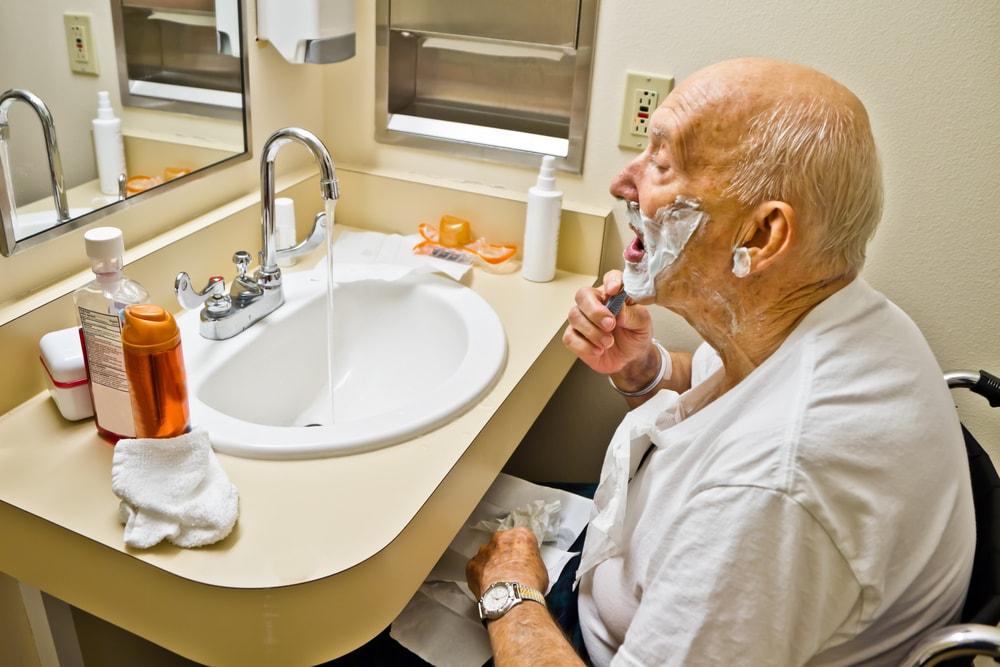There comes a time when older adults will need safety features installed in their bathrooms. This is primarily to ensure that they can take care of their hygiene and grooming needs independently. Elderly safe bathrooms are designed to be inclusive to aid caregivers in tending to seniors in nursing home situations.

Therefore, if you have an elderly family member, you should consider making some additions and changes to the bathroom they use. This will provide them with safety and comfort. Many of these ideas are simple to implement and go a long way to improving the wellbeing of older adults.
Here are five steps for creating an elderly-friendly bathroom.
- Mount Shower Caddies And Bathroom Racks
Placing shower caddies and racks on the walls and in the shower should be the first step to creating a usable and senior-friendly bathroom. It’s one of the most straightforward and cost-effective initial approaches that you can get done within a day.
However, make sure the caddies and racks are mounted just above head height and are no more than an arm’s length away from the toilet or shower head. Doing this makes it easier for older adults to access toiletries without reaching or moving about the bathroom to get them. This includes items such as towels for nursing homes and other personal care products.
Thus, these racks and caddies allow for everything to be organized in one place. This is particularly essential for elderly people with limited mobility.
- Add Non-Slip Flooring
It’s no secret that bathrooms can sometimes be slippery, which puts older people at risk of getting hurt. The solution is also simple: place non-slip rugs and mats adjacent to the bathtub and shower entrance.
Additionally, you can also put a tight-gripping mat inside the shower for your elderly to stand on. This is due to the many slip-related accidents that happen when washing. Meanwhile, large and cushioned rectangular mats that surround the drain tend to work best as they provide full coverage.
On the other hand, if you want to prevent falls throughout the bathroom, you can have ceramic-based matted floor tiles installed for their water-resistant properties.
- Install Hand Grips And Rails
The next step is also about creating safety and convenience for elderly people when they use the toilet or bathtub. This is especially necessary with low-lying toilets and bathtubs. They’re made to give seniors more support. Especially when they have to get into crouching positions to reach for the bathroom fixtures or get back up.
In this way, they can hold onto the grips and rails to steady and balance themselves without the need for further assistance. You can get grips and rails that are standalone frames bolted to the floor or wall that surrounds the bath and toilet. Alternatively, there’s a railing that can be connected to the toilet or on the bathtub rim to save space in smaller bathrooms.
- Get Bath And Shower Chairs
Elderly people can easily get tired standing or hunching for a long time when washing. Hence, getting a bath or shower chair will greatly benefit them. In the case that your elderly family member is living in a nursing home, these chairs also make it easier for their caregivers to wash them.
These specialized and height-adjustable chairs have slip-proof legs, sturdy frames, and raised handlebars to make them comfortable for seniors to sit on. When used in a bathtub, the chair is usually set up in conjunction with a padded bench. This is to help seniors get into the tub and place their bathing products on it.
In relation to this, it’s a good idea to install a handheld bathtub faucet so they can spray water directly onto themselves.
- Replace Faucets With Hand Levers
This final step is an additional consideration if you have an adequate remodeling budget and are okay with some construction. Replacing faucets might not be necessary, but they do contribute to making the bathroom easier to use independently for elderly people.
Easy-to-lift levers can be useful for seniors who have reduced motor strength and thus have difficulty opening faucets, which are often tightly shut. On the other hand, there’s a variety of different lever options available, such as foot-press-operated ones or levers with sensors for the bathroom sink. Therefore, if you’re going to have the faucets replaced, be sure to consult a plumber first for expert advice.
Conclusion:
Safety and fall prevention are the most important priorities when creating elderly-friendly bathrooms. This can be achieved by installing non-slip flooring options, chairs and rails in key sections of the bathroom.
In addition, other steps to integrate are about making it easy to operate bathroom fixtures that require challenging movements for older adults with lowered mobility to do, such as crouching and bending. In this case, you can put racks, hand grips, and levers in place to reduce the need for complex maneuvers. All of these steps together can create a cautious bathroom environment for senior family members.





